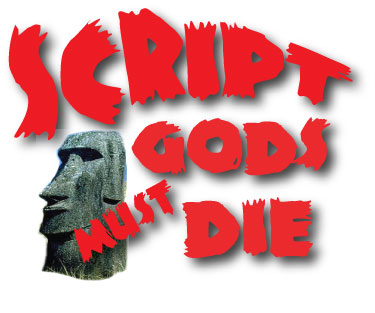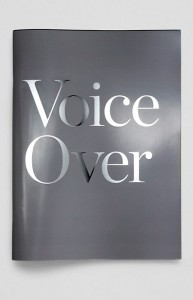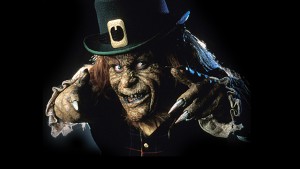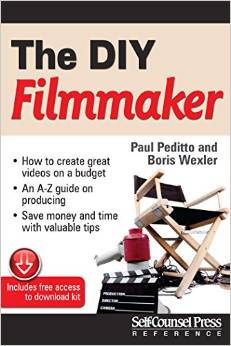This post is dedicated to folks who get confused on when to use Voice Over and when to use Off Screen.
- VOICE OVER
“… and God help you if you use voiceover in your work, my friends. God help you! It’s flaccid, sloppy writing. Any idiot can write voice-over narration to explain the thoughts of a character. You must present the internal conflicts of your character in action.”
This speech by the Robert McKee character in Adaptation is one of the funniest scenes ever about that heavily-debated topic in screenwriting: Voice Over! The very sound of it (along with its sister-device flashback) strikes fear! Horror stories of those foolish writers/directors who used voice over, and whose careers were never to be seen again!
Film is a visual medium. Too often we’re waiting for the narrator’s voice to end or start the scene. Or we’re listening to the narrator describe what we’re plainly seeing. Is there a tried and true test for the need of Voice Over? Not really. Common sense will have to do: Is there no visual way through action for you to introduce absolutely essential information that advances plot or character? No? Well then, it’s in. If it has to be Voice Over, then it’s Voice Over. And that’s ok!
Like with everything else in the screenwriting universe, there are no absolutes. I’ll bet you can name half a dozen movies that use voice over to devastating effect. Want a couple examples? Here’s one, from Forrest Gump:
EXT. RURAL ALABAMA
A black and white photo of General Nathan Bedford Forrest.
The photo turns into live action as the General dons a hooded sheet over his head.
The General is in full Ku Klux Klan garb, including his horse.
The General rides off, followed by a large group of Klan members dressed in full uniform.
FORREST (V.O.)
She said we was related to him in some way. And, what he did was, he started up this club called the Ku Klux Klan. They’d all dress up in their robes and their bed sheets and act like a bunch of ghosts or spooks or something. They’d even put bed sheets on their horses and ride around. And anyway, that’s how I got my name. Forrest Gump.
Signature voice. You can’t imagine the movie without it. In fact, the movie couldn’t function without it. Read the script. There is no way the same story could be told without it, which is the measure of the need of V.O. There are many haters of Voice Over. I am not one of them. Here’s another example, from V For Vendetta:
In the darkness, we hear a voice, a woman’s voice. Her name is Evey.
EVEY (V.O.)
“Remember, remember, the fifth of November, the gunpowder treason and plot. I know of now reason why the gunpowder treason should ever be forgot.”
Her voice has a strength that is metered by a calmness, a deep centered peace that we can feel.
EVEY (V.O.)
Those were almost the very first words he spoke to me and, in a way, that is where this story began, four hundred years ago, in a cellar beneath the Houses of Parliament.
In the darkness, we find a lantern. Guy Fawkes, a dangerous man who wears a goatee, is struggling with a wheelbarrow stacked with barrels of gunpowder.
EVEY (V.O.)
In 1605, Guy Fawkes attempted to blow up the Houses of Parliament.
The wheelbarrow bumps over the heavy stone mortar of the cellar floor. From the dark depths, we hear the sound of dogs.
EVEY (V.O.)
He was caught in the cellars with enough gunpowder to level most of London.
Guy sees lanterns coming from both sides. He tries to run as the dogs reach him first. He grabs for his sword as dozens of pole axes pin him against the tunnel’s stone wall.
Concerning Voice Overs, the Script Gods Must Die rule applies: No other visual way through action for you to introduce absolutely essential information that advances plot or character? No? Then, damn the torpedoes and use Voice Over!
- OFF-SCREEN
Off-Screen (O.S.) differs from Voice Over in that the character is present, just not seen.
Here’s an example from Taxi Driver:
Dishelved middle-aged New Yorker looks up from the desk. We CUT IN to ongoing conversation between the middle-aged PERSONNEL OFFICER and a YOUNG MAN standing in front on his desk.
The young man is TRAVIS BICKLE. He wears his jeans, boots and Army jacket. He takes a drag off his unfiltered cigarette.
The PERSONNEL OFFICER is beat and exhausted: he arrives at work exhausted. TRAVIS is something else again. His intense steely gaze is enough to jar even the PERSONNEL OFFICER out of his workaday boredom.
PERSONNEL OFFICER (O.S.)
No trouble with the Hack Bureau?
TRAVIS (O.S.)
No Sir.
PERSONNEL OFFICER (O.S.)
Got your license?
TRAVIS (O.S.)
Yes.
PERSONNEL OFFICER
So why do you want to be a taxi driver?
TRAVIS
I can’t sleep nights.
PERSONNEL OFFICER
There’s porno theatres for that.
TRAVIS
I know. I tried that.
Paul Schrader gives us the setting, using O.S. so that we hear the full conversation, but don’t see who talks until halfway into the scene. Here’s another excellent O.S. sequence, from X-Men:
WASHINGTON D.C. – THE NOT TOO DISTANT FUTURE
A woman’s voice holds over the proceedings. It is the voice of JEAN GREY – whom we will soon meet. As she is speaking, we come to a large screen television at one end of the room.
JEAN (O.S.)
In every organism on Earth there exists a mutator gene – the X-factor, as it has come to be known. It is the basic building block of evolution -the reason we have evolved from homo habilus…
FOOTAGE REFLECTS THE VARIOUS STAGES OF HUMAN EVOLUTION. Accompanying it is a GRAPH with a DIAGONAL LINE indicating the ascent of the “human being” as we know it. Accompanying the graph are evolving images of the “evolution of man.”
JEAN (O.S.)
to homo erectus, to homo sapiens, Neanderthals, and, finally, to homo sapiens.
The animated demo on the screen zooms in on the lowest order of human depicted – homo habilus – a primitive, ape- like humanoid covered in hair. As he is singled out, the terrain of his time appears, along with the harsh signs of his winter.
JEAN (O.S.)
Taking its cues from the climate, terrain, various sources of nourishment, the mutator gene tells the body when it needs to change to adapt to a new environment. The process is subtle, normally taking thousands of years.
As the graphic changes and depicts WARMER CLIMATE, the HAIR STARTS TO DISAPPEAR ON THE MAN’S BODY — gradually evolving into the human we now know as ourselves.
Now the terrain is modern, the weather pleasant. The image pulls back and places this man back in line at the front of evolution.
JEAN (O.S.)
Only in the last few thousand years did mankind begin to make clothes for himself, build shelters, use heat and grow food in large quantities. With this man-made environment remaining relatively stable, the X-factor became dormant.
QUICK SHOTS: early huts, early clothing; then early homes, later homes, air conditioning, cars, modern high- rises, etc.
PULL BACK WIDER
JEAN (O.S.)
Until now.
Keep in mind with production drafts, you’ll sometimes find screenwriters directing like above (QUICK SHOTS, PULL BACK WIDER.) You get scripts that look like this, from Leprechaun:
As he lays there, breathing heavily… then we begin to HEAR STRANGE “IRISH MUSIC” coming from the crate. Then his MOTHER’S VOICE begins to sing the Irish song “Danny Boy” in the most beautiful voice we’ve ever heard…
LEAH’S VOICE: (singing “Danny Boy”) Oh, Danny Boy… the Saints they are a’calling…
Now we CRANE BACK… and…
SMASH CUT TO:
“YUMMY, YUMMY, YUMMY I GOT LOVE IN MY TUMMY” 70’s rock and roll song blasting out of:
TIGHT ON A CAR’S TAPE DECK
that is playing the song that brings back memories of a summer in the seventies.
ON A BEAT-UP OLD JEEP, open top, traveling down a country road. A beautiful morning. And the SONG CONTINUES as we roll credits. The driver of the jeep, J.D. REDING, is singing along with the song.
Do not direct your spec script! When you give us camera angles you take us out of the reading experience. You also encroach on the director’s domain. Don’t do it.
Good Reader, all my advice is geared toward helping you find the money to make your movie. Of course if you’ve already got the money, forget everything I’ve said. I mean it. Go ahead and write in camera angles; write in every SMASH CUT and CRANE shot; while you’re at it, write the script in 9 fonts, or in pink Crayola crayon. You’ve got the money!




HERB (O.S.)
Thank you very much. I knew how to use these but was not sure of the format. I was not sure where to place them. I was doing parentheticals. Wrong. If I have it straight now, then parentheticals are actor directives and character extensions are director suggestions, which is why they should be avoided if possible. Let the actors act and let the directors direct.
p.s. Forrest Gump was great use of V.O., another and imho, the best use of V.O. was the original Bladerunner.
and Molly’s Game. There is no end to kick ass movies that have used Voice Over. Anyone who makes a blanket negative statement on them is flat out ignorant.